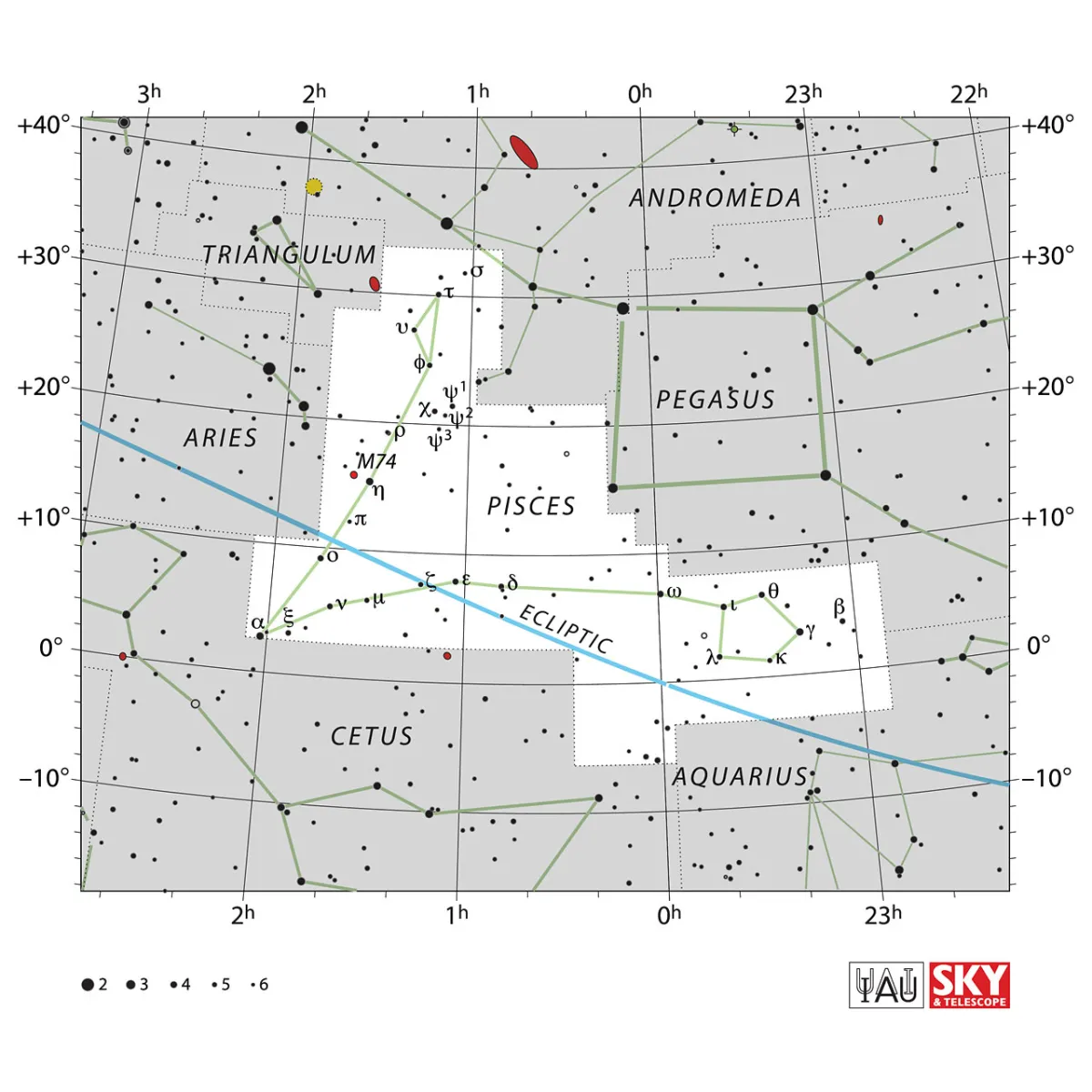Constellation Pisces (Fishes)

Properties
The constellation consists mainly of weaker stars averaging 4th size and depicts two fish that are knotted on their tails. The node itself is marked by the star alpha Piscium. Pisces is located south and southeast of Pegasus and south of Andromeda. The most striking feature of this inconspicuous constellation is an ellipse of seven faint stars south of the Pegasus rectangle. Pisces covers an area of 889 square degrees and the centre culminates around midnight on September 27th. [9]
| α Psc | Alrisha, Alrischa, Alrescha, El Rischa, Al Richa, Rescha, Okda, Kaitain |
| β Psc | Fum Al Samakah |
| ο Psc | Torcularis Septentrionalis |
| IAU Name | Pisces |
| IAU Genitive | Piscium |
| IAU Abbr. | Psc |
| English Name | Fishes |
| Culmination at local midnight | 6 October |
| Season (Latitude +0.0°) | June … March |
| Right Ascension (J2000.0) | 22h 51m 17s … 02h 06m 40s |
| Declination (J2000.0) | -06° 18' 27" … +33° 40' 55" |
| Area | 889 deg2 |
| Neighbours (N↻) | And, Peg, Aqr, Cet, Ari, Tri |
Deep-Sky Object Descriptions
Catalogues
Mythology and History
In ancient Greek mythology, these fish represent Aphrodite and her son Eos. Both were swimming when a monster, Typhen, suddenly appeared and scared them. To escape the monsters, the two turned into fish, held together by a ribbon so that they would not be separated. In order to preserve the memory of this moment, the two were placed on the vault of heaven. [83]

Another version of this story tells how giants, gigantic sons of the earth once wanted to storm the sky. Typhon in particular, a giant with a hundred arms, terrified the people of heaven. All fled and the heavenly ones tried to hide themselves by taking on earthly forms. Zeus turned into a bell-bell, Apollo into a raven, Dionysus into a goat, Artemis into a cat and Hera into a white cow. In this confusion, two fish that romped about in the Euphrates proved to be particularly helpful to the gods:
When Zeus was defending the sky with arms, Aphrodite came to the Euphrates, only accompanied by her little son Cupid, fleeing from the grim Typhon and settled on the bank of the Palestinian river. Above, reeds and poplars lined its banks, and the willows gave hope for a heavenly shelter. When they were in hiding, the wind sang in the forest. Aphrodite turned pale with shock and believed that the enemy's rulers were there. She pressed her boy's chest and called the nymphs for protection. Without hesitation, she then jumped into the water. Two fish offered their backs, for which they now have the stars as a worthy gift. [7, 20]
In the Alfonsin Tables (1215) this constellation is known as Pesces. In the edition of the Ptolemaic Almagest from 1515 one reads Echiguen, or in the German astronomer Bayer (1572-1625) Ichiguen. Both names are mutilated words for the Greek expression Ichthues (fish). The Romans often referred to the fish as Imbrifer Duo Pisces, the two rain-bringing fish, but also Gemini Pisces and Piscis Gemellus, i.e. as a pair of fish. The story of the two gods who threw themselves into the Euphrates for fear of the giant Typhon is reflected in the names Venus et Cupido, Venus Syria cum Cupidine and Venus cum Adone.
In the Christian realm of thought, the fish are a reminder of the miracle of Christ on the occasion of the feeding of thousands of people. The fish were also an ancient symbol of the Christian faith. [20]